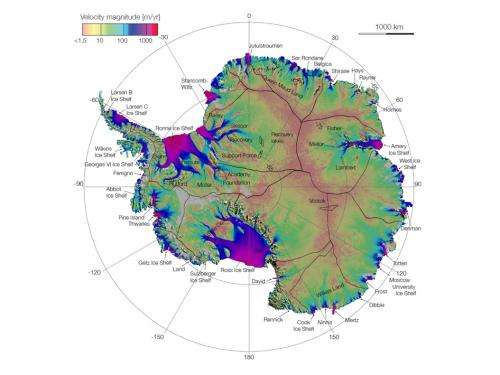Researchers chart long-shrouded glacial reaches of Antarctica

(PhysOrg.com) -- A vast network of previously unmapped glaciers on the move from thousands of miles inland to the Antarctic coast has been charted for the first time by UC Irvine scientists. The findings will be critical to tracking future sea rise from climate change.
"This is like seeing a map of all the oceans' currents for the first time. It's a game changer for glaciology," said UCI earth system science professor Eric Rignot, lead author of a paper on the ice flow published online today in Science Express. "We're seeing amazing flows from the heart of the continent that had never been described before."
Rignot, who is also with NASA's Jet Propulsion Laboratory, and UCI associate project scientists Jeremie Mouginot and Bernd Scheuchl used billions of points of data captured by European, Japanese and Canadian satellites to weed out cloud cover, solar glare and land features. With the aid of NASA technology, they painstakingly pieced together the shape and velocity of glacial formations, including the huge bulk of previously uncharted East Antarctica, which comprises 77 percent of the continent.
These animations shows the motion of ice in Antarctica as measured by satellite data from the Canadian Space Agency, the Japanese Space Agency and the European Space Agency, and processed by NASA-funded research from the University of California, Irvine. The background image from the Landsat satellite is progressively replaced by a map of ice velocity, which is color-coded on a logarithmic scale.
Like viewing a completed jigsaw puzzle, Rignot said, the men were stunned when they stood back and took in the full picture. They discovered a new ridge splitting the 5.4 million-square-mile landmass from east to west. They found unnamed formations moving up to 800 feet each year across immense plains sloping toward the Southern Ocean – and in a different manner than past models of ice migration.
"These researchers created something deceptively simple: a map of the speed and direction of ice in Antarctica," said Thomas Wagner, a cryospheric program scientist with NASA's MEaSUREs program, which funded the work. "But they used it to figure out something fundamentally new: that ice moves by slipping at its bed, not just at the coast but all the way to the deep interior of Antarctica."
"That's critical knowledge for predicting future sea-level rise," he added. "It means that if we lose ice at the coasts from the warming ocean, we open the tap to the ice in the interior."
The work was completed during a period called the International Polar Year, and is the first such study since 1957. Collaborators working under the aegis of the Space Task Group were NASA, European Space Agency, Canadian Space Agency, Japanese Aerospace Exploration Agency, as well as the Alaska Satellite Facility, and MacDonald, Dettwiler & Associates Ltd.
"To our knowledge, this is the first time that a tightly knit collaboration of civilian space agencies has worked together to create such a huge dataset of this type," said Yves Crevier of the Canadian Space Agency. "It is a dataset of lasting scientific value in assessing the extent and rate of change in polar regions."
Provided by University of California - Irvine
















